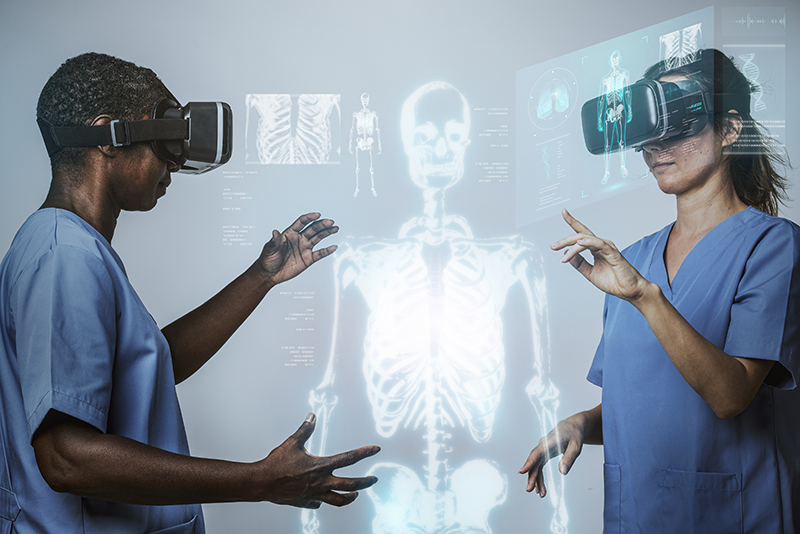
Table of Contents
In several areas, including medical transcription, the medical industry has embraced the power of artificial intelligence (AI). The method of transforming audio recordings of medical experts into precise written documents has been transformed by artificial intelligence algorithms and natural language processing approaches. With the development of AI technology, healthcare professionals are now able to produce a tremendous amount of accurate, educational, and patient-accessible healthcare information.
You can produce accurate transcription with exceptional speed and precision using an AI algorithm and reliable medical transcription services, which would save healthcare professionals time and effort. These services currently use AI-assisted medical transcription systems, which use AI to turn spoken words into written documents or transcripts. Software that can detect when someone is speaking and swiftly translate what they say into text is created by developers using machine learning.
Role of AI in Medical Transcription
By speeding up the procedure and increasing accuracy, AI significantly contributes to the improvement of medical transcription. Utilizing AI technology, medical transcription services automate and speed up the conversion of voice recordings made by healthcare experts into text format. By automating the transcription of audible words into text, speech recognition algorithms powered by AI save time and effort compared to manual transcription. Additionally, medical terminology and context can be analyzed and interpreted by AI algorithms, providing accurate and consistent documentation. By locating and fixing errors, enhancing grammar, and preserving a consistent style throughout the transcription, natural language processing (NLP) techniques increase accuracy even more. Additionally, AI facilitates smooth data transmission and increases the effectiveness of medical documentation by integrating medical transcription services with electronic health record systems. AI enables transcription providers to provide quicker, more accurate, and dependable transcription solutions, which ultimately benefits both patients and healthcare practitioners.
Advantages of AI-based Medical Transcription
- Instant transcription: In a doctor-patient conversation, real-time AI-based medical transcription software solutions listen for medically relevant information and only save the relevant information. As a result, it doesn’t record brief talks like dictation software would; instead, it just records the important information. These solutions can identify intricacies in a conversation using modern NLP engines, eliminating extraneous lines and preserving only the relevant information. Since AI-based medical transcription software and solutions record everything as the dialogue occurs, doctors don’t need to spend hours digitizing their notes. This not only significantly shortens the process but also saves time.
- Enhanced medical transcription accuracy: AI-based software programs have the ability to learn from their errors. Therefore, after completing their notes, doctors verify the records to make sure everything is in order. Additionally, the AI tool uses whatever modifications a doctor makes as data points. If the doctor corrects a mistake of a similar sort more than a predetermined number of times, the AI tool becomes aware of its error and learns from it.
- Increased patient comfort: It is reasonable to believe that somebody seated in front of a physician is not just stopping by to say hi. When a patient comes to a doctor, he or she will always be tensed and if the doctor makes notes while diagnosing on his computer, iPad, or notebook, the patient becomes agitated very soon. However, as AI-based medical transcription software becomes popular, doctors are able to give their entire attention to their patients because the computer accurately takes notes and inserts them into the EHR. This not only simplifies and enhances the patient’s experience, but also improves the doctor’s performance.
- Integration: You can incorporate AI transcription into your website or program, which is an additional benefit. You can develop ‘always on’ functionality in this way to improve usability and productivity for your staff or consumers. This is how a lot of voice recognition-dependent services work. Integration may be as straightforward as using Google Drive and Dropbox. You can upload your audio file to one of these providers using Rev’s interface with them, and you’ll instantly get a text file in return.
While recording what is said in an audio recording using AI-assisted speech recognition may seem like an easy task, background noise, strong accents, and several speakers might make good automated transcription hard. These are the areas where voice recognition still needs improvement. Transcriptionists must enter the picture in order to overcome these mistakes.
This is why medical transcription still plays a crucial role in the medical industry. Since individuals can understand language and accents better than any machine, human transcription is more accurate than speech transcription by artificial intelligence. Humans are also more adept at handling background noise and various speakers than machines are. This is why healthcare organizations must invest in medical transcription outsourcing services that use AI as well as human transcriptionists to produce accurate healthcare content.


